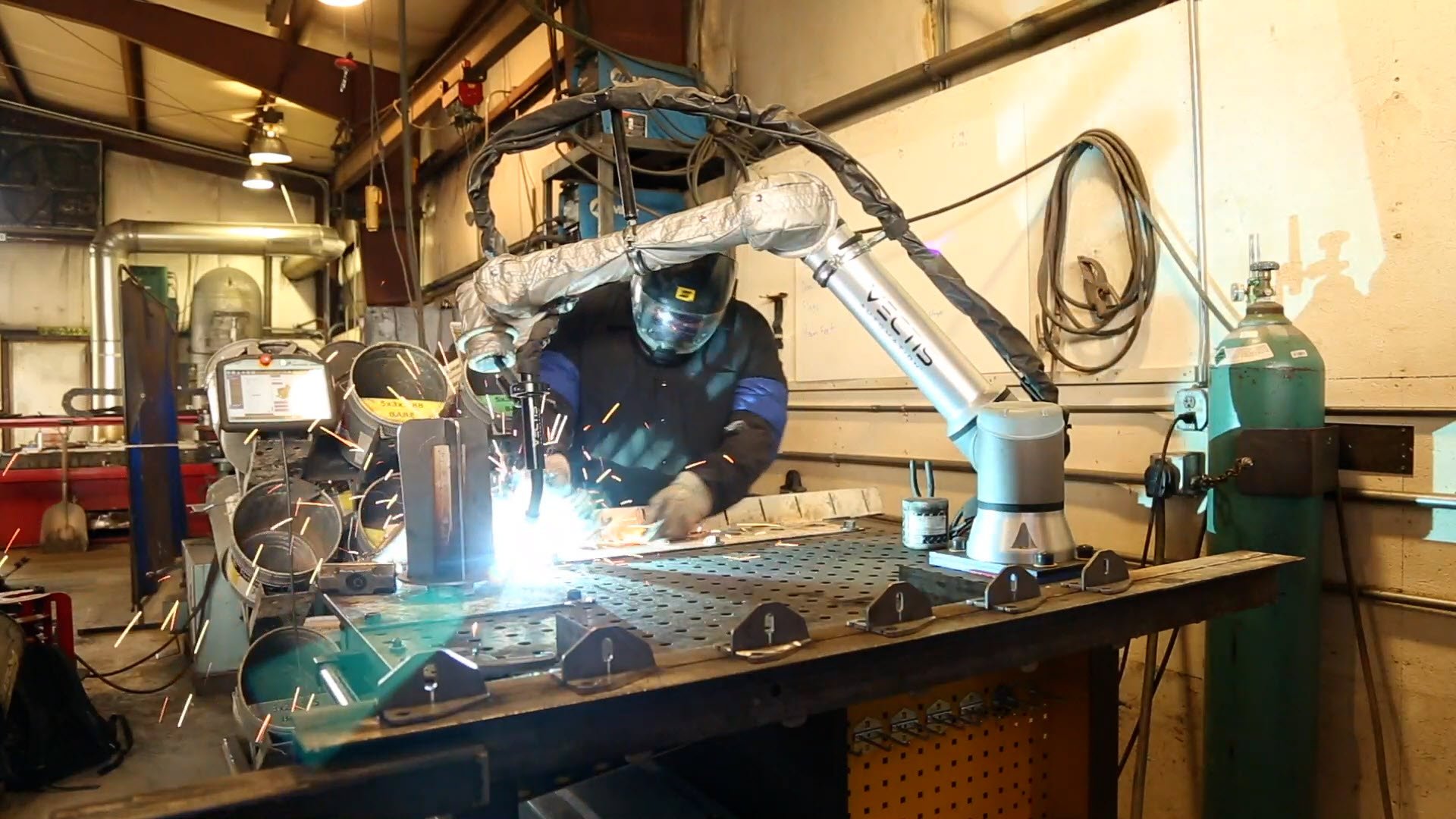
Cobots are boosting productivity 3-4x in fab shops of all types & sizes.
With over 750 Vectis systems deployed, you can trust our team & tools to help your shop
DO MORE WITH LESS
As the industry pioneer & leader, Vectis Automation empowers your cobot welding & cutting success with:
Our focused team of experts. 200+ years of robot fabrication experience – and no distractions from other product lines.
A proven track record. Over 750 cobot welders & cobot cutters deployed, dozens of repeat customers, and a 94% recommendation rating.
The most comprehensive cobot fabrication portfolio. Tackle a broader variety of applications on a common platform.
Crazy easy programming that doesn’t compromise on powerful features. Leverage QuickTeach™, AI path optimization, touch sense, seam tracking, pattern tool, and more.
Peace of Mind. Eliminate risk with our unprecedented 30-day Money Back Guarantee, rent-to-own options, and 2 year bumper-to-bumper warranty
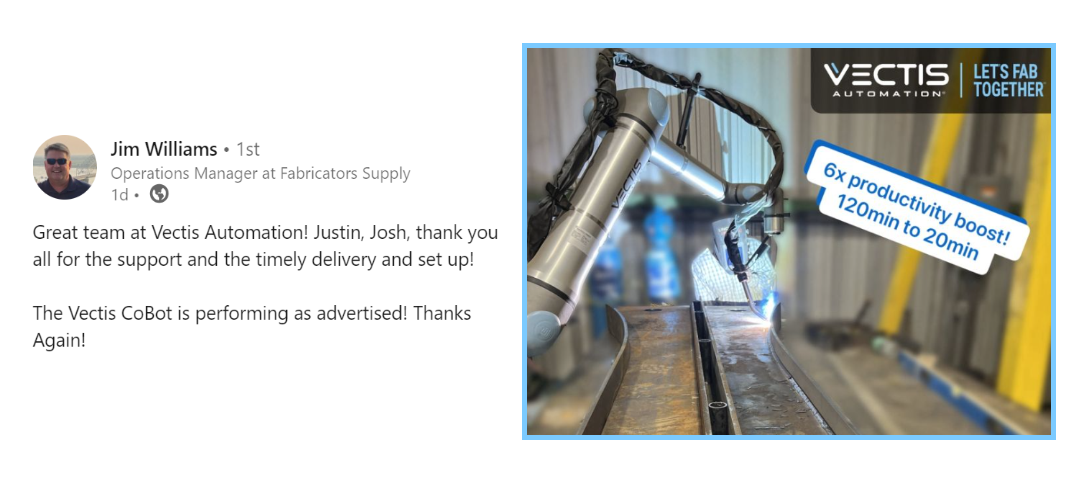
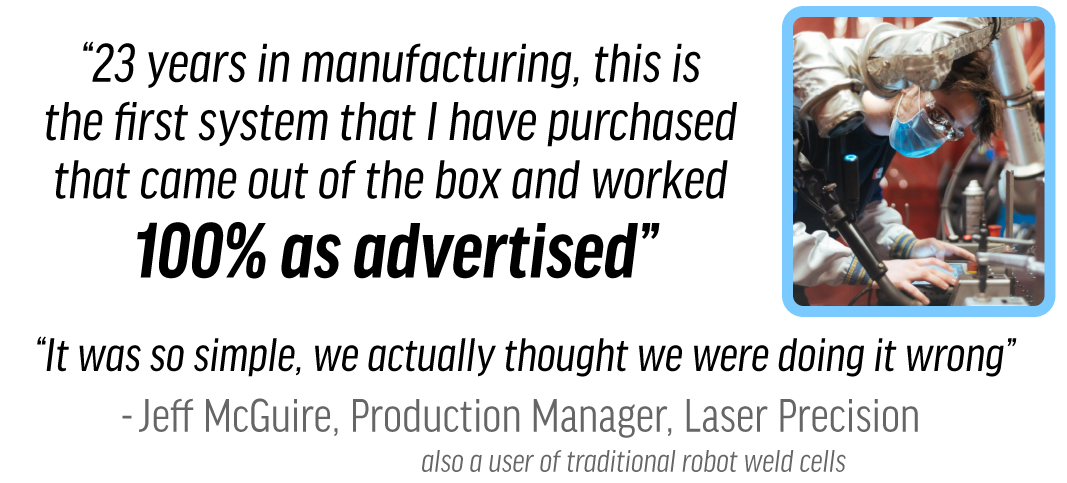
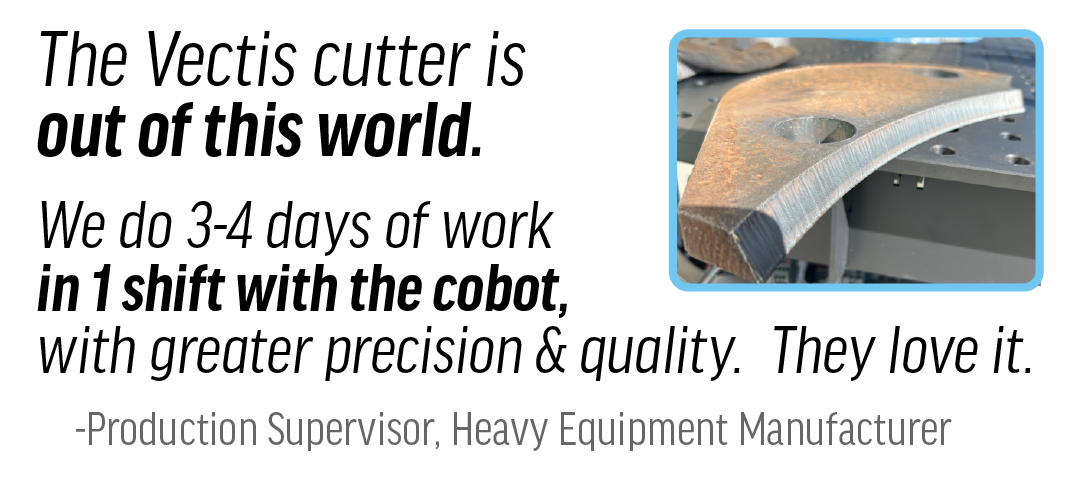
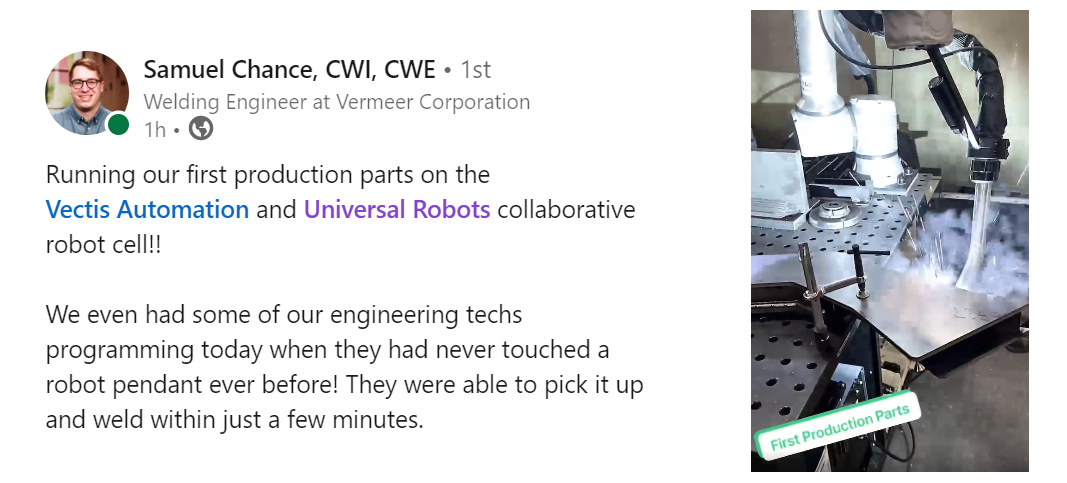
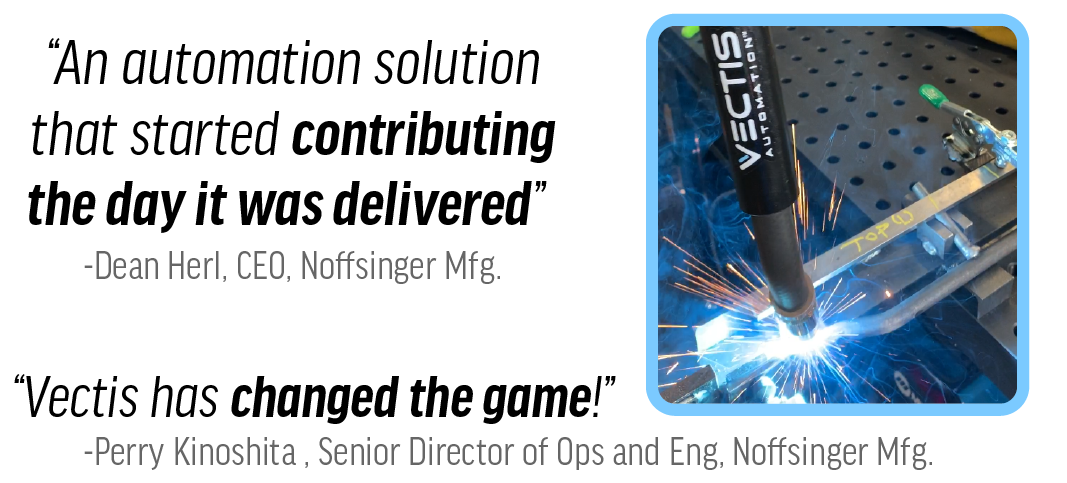
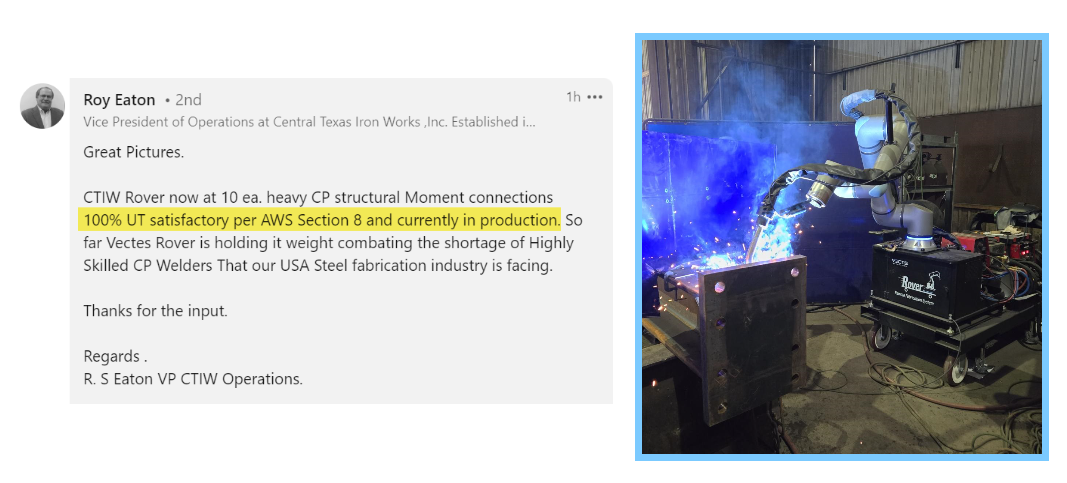
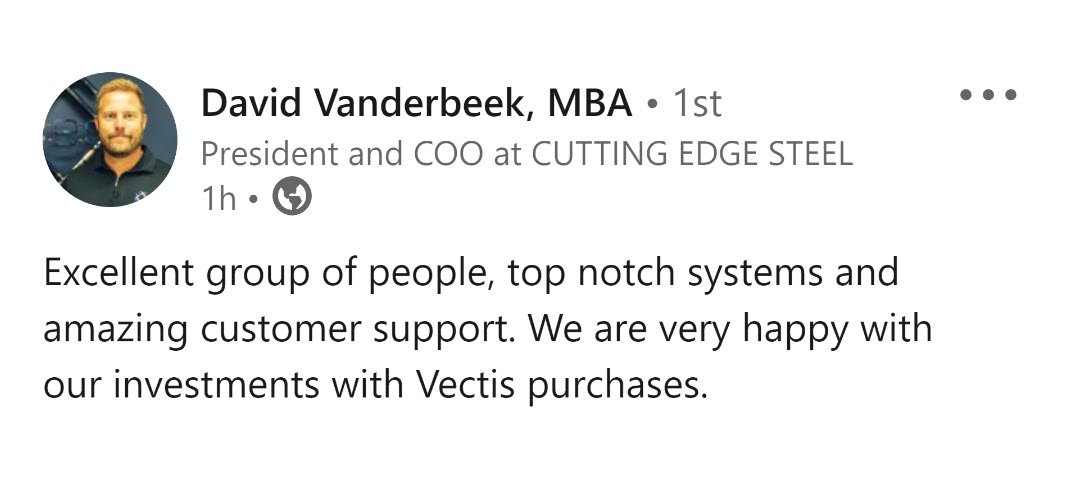
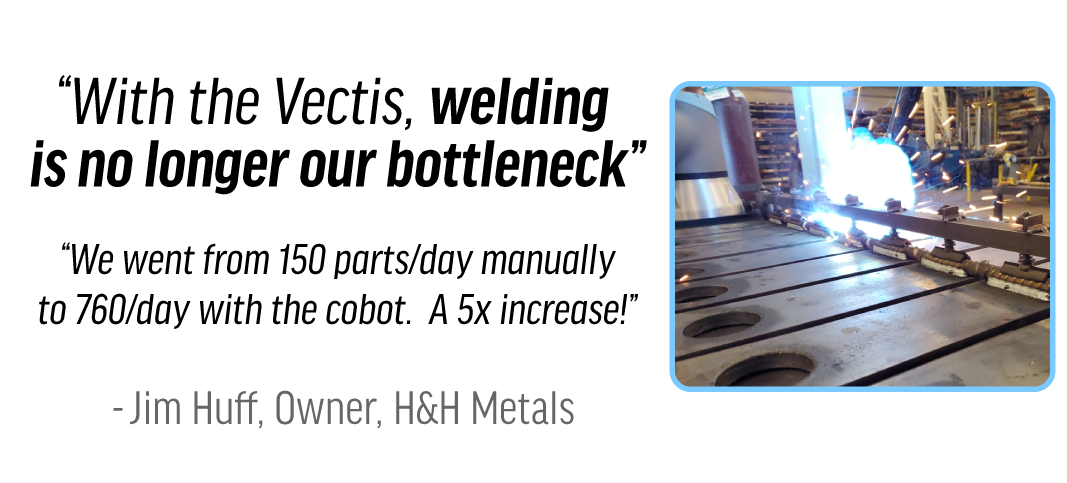
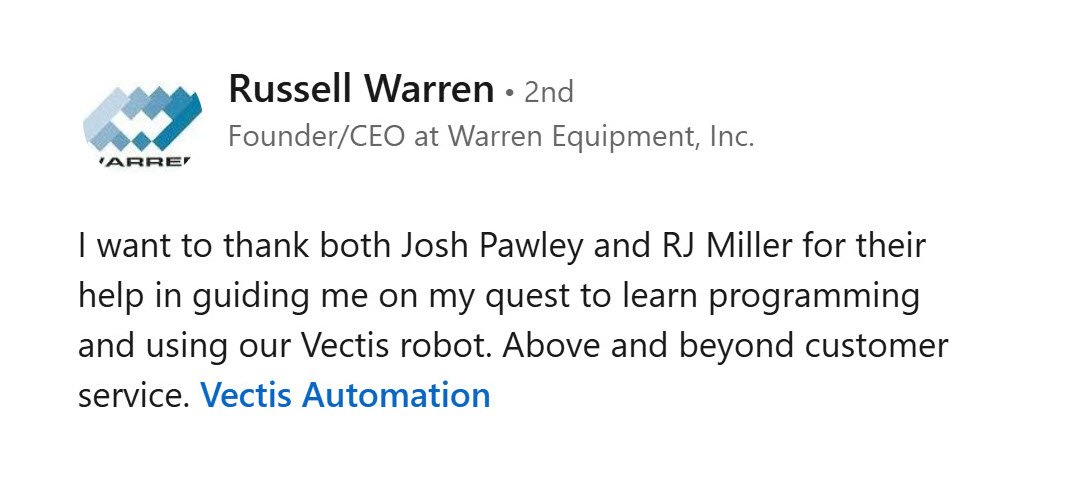
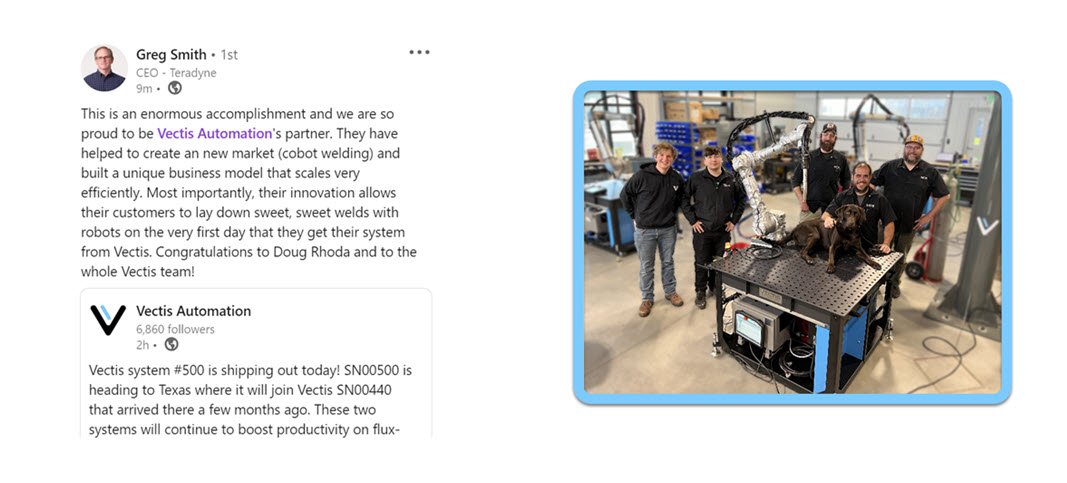
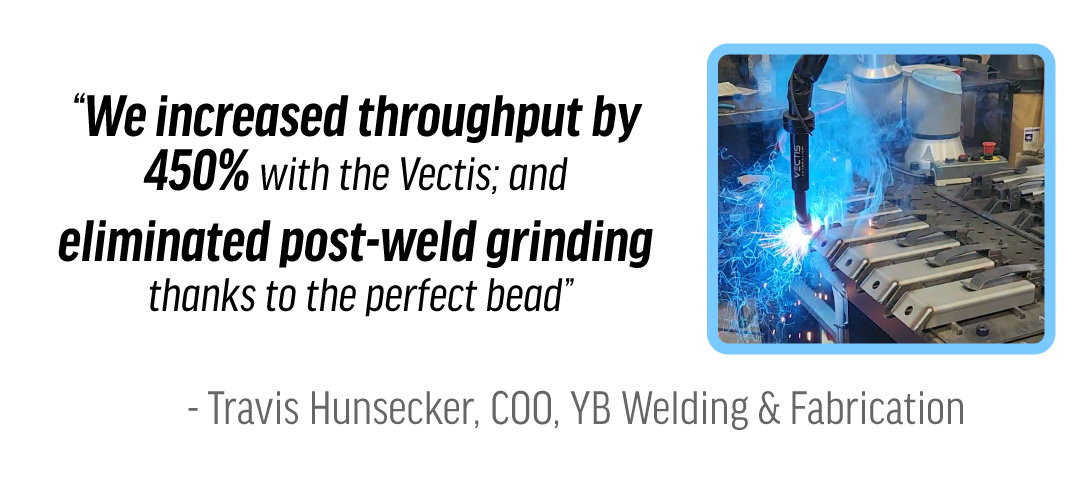
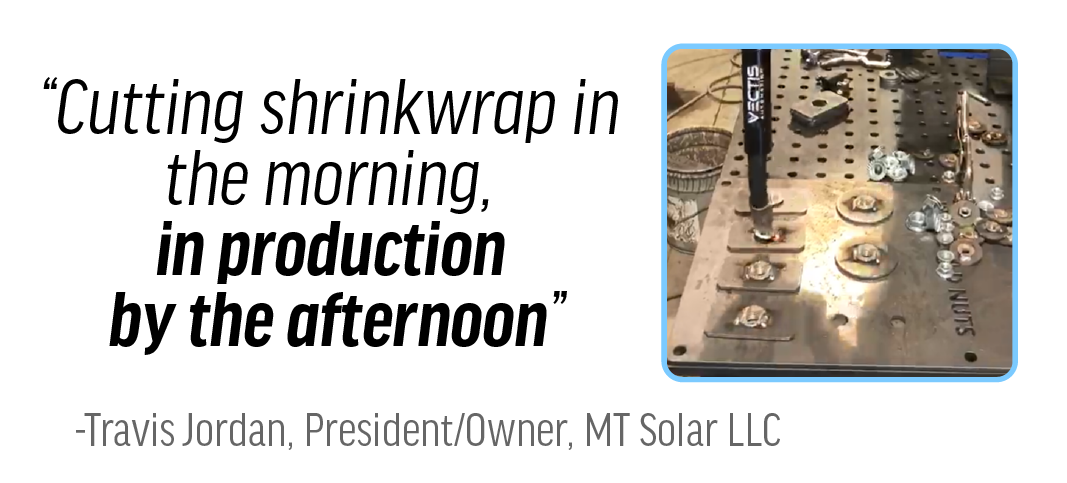
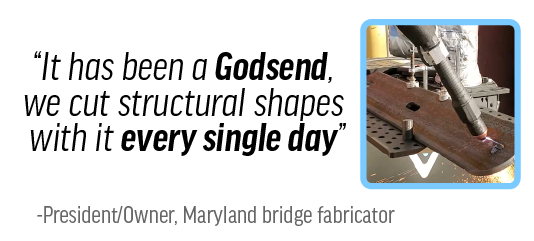

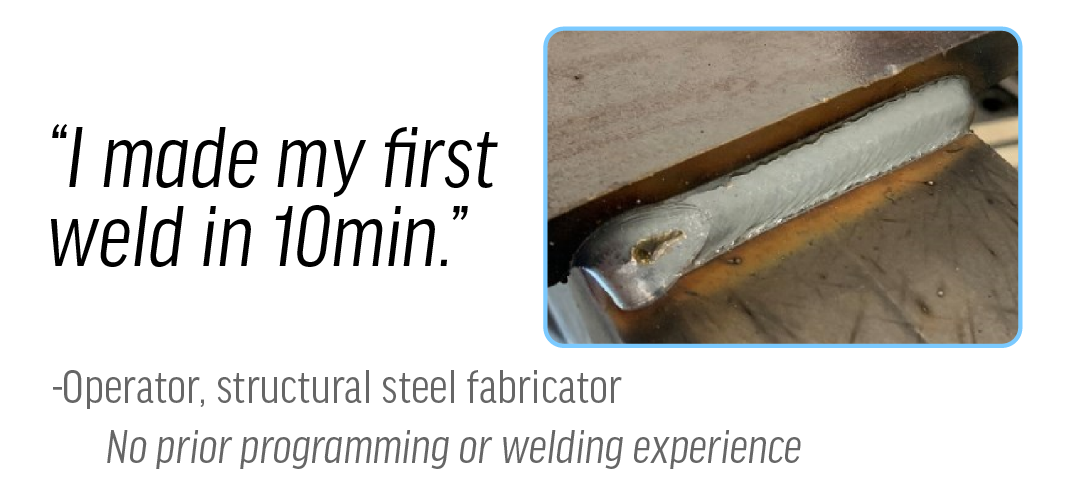
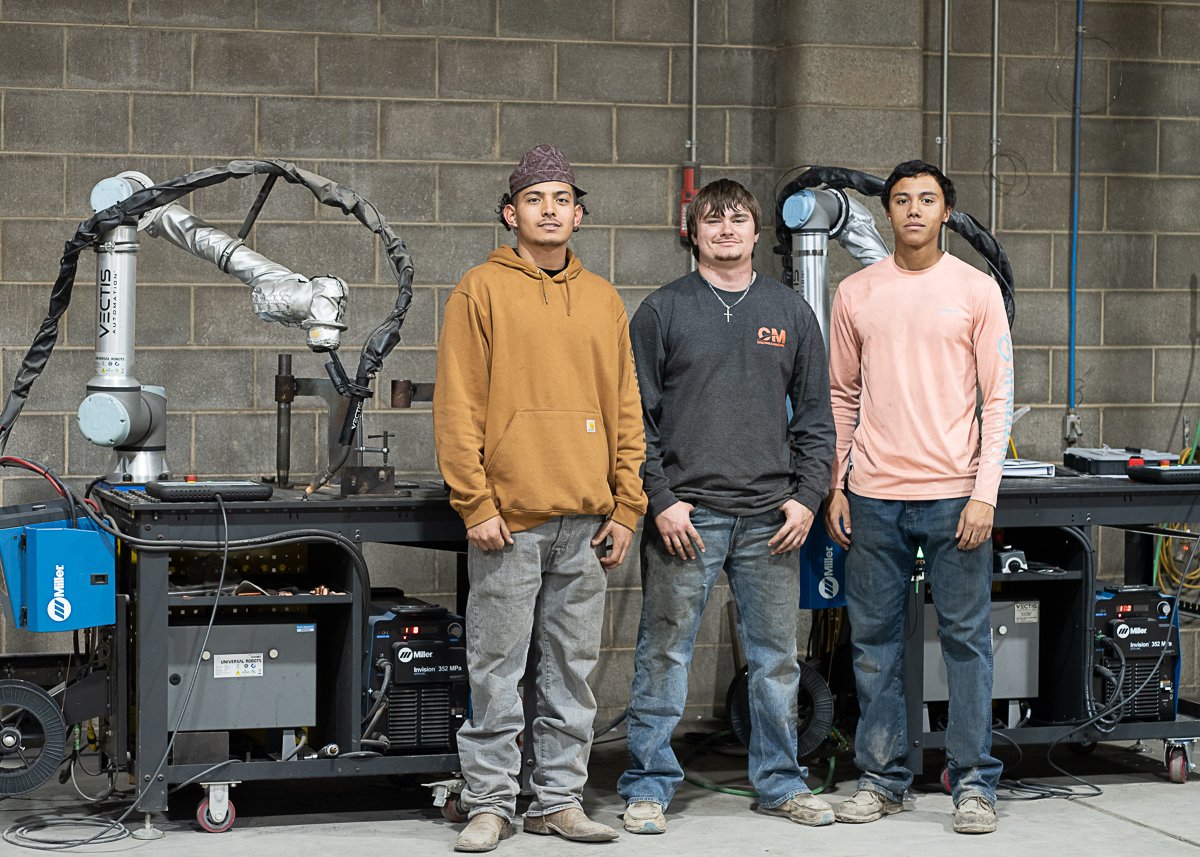
THE CHALLENGE: A Continued Shortage of Skilled Labor
360,000
Shortage of Skilled Welders by 2027
We know we're preaching to the choir here, but there is a severe lack of fabricators in the U.S., Canada, and Mexico. And it's not getting better anytime soon - the American Welding Society estimates the average age of a welder to be 54 years old, and there simply aren't enough incoming welders to fill their shoes...leading to a potential shortage of 360,000 welders by 2027.
Vectis can help you tackle this challenge in two symbiotic ways:
1) Finish batches of weldments 3-4x faster - even those medium batches of 20, 50, 200 parts.
2) Attract new talent to your workforce as Champions for your exciting-to-use cobots.
THE SOLUTION: Vectis Cobot Welding & Cutting Tools
People + Tools = Increased Productivity
COLLABORATIVE FLEXIBILITY
Powered by industry-leading Universal Robots cobots; a proven 5th-gen platform with 100,000 arms deployed.
Built-in cobot safety & proprietary Vectis deployment methods allow for maximum flexibility.
Portable versatility - no need for a dedicated footprint nor a fixed work envelope.
HIGH-FUNCTION, STILL CRAZY EASY
No programming experience necessary.
Make your first cobot weld/cut within 10 minutes of plug-in using our intuitive interface, weld templates, and tutorials.
DIY install, setup, and training to save you time and money. No need to fly to our facility nor pay for an on-site tech.
94% Recommendation Rating from Customers
PEACE OF MIND
Less Risk: Vectis’ rent-to-own options, 30-day Money Back Guarantee, and 2yr warranty reduce your risk exposure.
Less Struggle: Our expert team always starts with an application evaluation to avoid surprises. Those same experts support you post-sale.
Less Waiting: Typical lead time is a few weeks.
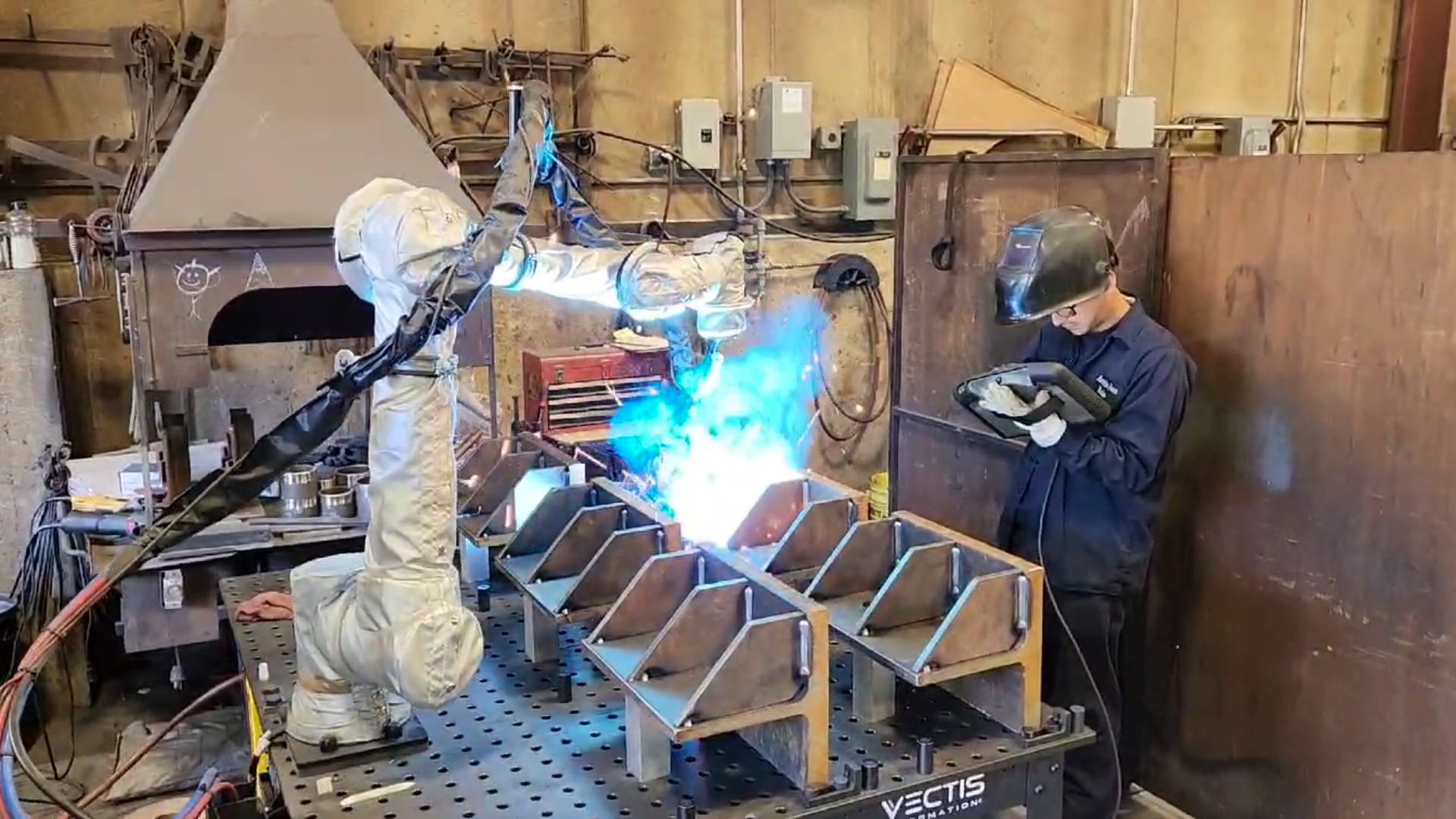
Welding Cobot Success starts with:
Right Application & Right Champion
With over two centuries of combined experience in the robot & cobot welding industry, we know what makes automation actually work in production.
Our mission is not to just sell you a cobot welding / cutting system. Our mission is to provide you with a practical solution to increase your fabrication capacity, quality, and stability. A key part of the Vectis process is collaboratively reviewing your application to provide insight on application viability and how to achieve success in production. We will always give you an honest answer.
Cobot Welding & Cutting FAQ
-
A collaborative robot, or “cobot”, is a unique type of six-axis robot that can work alongside humans and is often very easy to program. It is able to work alongside humans via force-torque sensors that protect the operator from harm.
-
The majority of our systems cost $95k-$140k all-in; depending on configuration. This includes full plug-n-produce integration, shipping, 2yr warranty, lifetime software license, and our unprecedented 30-day return policy. Oftentimes customers find our prices to be 25-40% less than traditional robot cells and other competitors. You can view our pricing spectrum by clicking here; or request a formal quote here
-
Most of our customers report a payback of 2 years or less; through a typical weld batch productivity boost of 3-4x. This results in a weld labor savings of 3-4x per batch of parts. There are numerous other benefits as well - including talent attraction/retention, higher quality, less grinding, offloading the boring arc-on time so your skilled welders can focus on higher-skill tasks, and increased capacity to take on new business!
-
We’ve been asked how to calculate these intangibles; which ends up being very dependent on your specific scenario and pain points. Here are some points we’ve heard from existing customers:
Reduced rework/scrap due to poor-quality manual welds (or missed welds): Look at COPQ metrics – rework, scrap rate, field failure rate, etc to see if some could be solved through improving quality of welds
Reduced training time for new welders – operating the cobot doesn’t require the same dexterity/experience as manual welding, so the learning curve is much quicker. Look at training cost and turnover cost metrics
Talent attraction & retention tool. Look at cost of recruitment, and opportunity cost of not having enough welders on-hand to meet current demand (if this is a challenge you currently face – many of our customers state this is the #1 reason to automate – meet current/future demand).
Reducing grinding/clean-up time (sometimes even eliminated). This can sometimes be an even greater financial and EHS impact than the weld labor savings. To calculate, look at amount of grinding/clean-up time related to the applications you’re looking to cobotically weld. Conservatively reduce it by 50%; or 100% (eliminate) if you want to be aggressive.
Ability to bring in new business due to increased capacity. Look at “opportunity cost” – “if we had Xhrs more welding capacity, how much more revenue would that allow us to generate?”, with the Xhrs provided by the increased productivity of the cobot
-
The most common challenges we see are A) poor consistency caused by upstream equipment and/or fixturing; B) trying to bite off too much in the first stages - it’s important to crawl/walk before you run! and C) lack of champion/ownership. We address these challenges & how to conquer them in further depth in our Keys to Success. As well, our cobot welding experts are here to guide you through these challenges for your specific applications - reach out to us today to start the conversation!
-
Yes! We have over 750 Vectis systems in the field; welding & cutting day-in and day-out. As well, our cobot arms we use from Universal Robots have been deployed in over 100,000 applications worldwide.
-
Yes & yes, so long as the parts fed to the cobot are consistent! The Universal Robots arms we integrate into our welding & cutting systems have a positional repeatability of ± 0.1 mm (~0.004”) with payload per ISO 9283. The primary factor to accurate welds is the consistency of the parts and the fixturing; which we can help you with.
If the parts are consistent, you can make some absolutely beautiful welds that pass inspection with flying colors. Check out some of the welds customers have made with the Vectis by clicking here to head to our gallery
-
Quite the opposite! The overwhelming majority of our customers report an expansion of their welding operation due to the increased capacity cobots provide their weld shop.
Even more excitingly, cobots still need human Champions! The cobot allows fabricators to offload the boring arc-on time to the cobot; allowing your team members to both Upskill & Focus-Skill on other, more interesting tasks!
-
Cobots can weld as fast as the material & welding process allow. For a common 1/4” mild steel fillet; this could be in the realm of 18-25ipm weld travel speed depending on material quality & joint consistency. There are certainly welds that run slower (larger and/or gap-prone); and ones that run faster (we have a customer running 93ipm on thin aluminum!).
Since the weld travel speed is largely dictated by the material & process (regardless of who/what is holding the torch); the cobot’s typical 3-4x productivity boost is largely provided by its increased arc-on time relative to manual welding.
-
Most customers are finding economic returns with batch sizes between 20 — 1,500. However, there are plenty of outliers on both sides. Some customers are finding economic returns programming one-offs based on quality improvements. Others are welding thousands of parts and enjoying the ease-of-programming, smaller footprint, and collaborative flexibility.
-
Our cobot tools can weld a broad variety of materials - carbon steel, stainless, steel, aluminum, and exotic metals (Inconel, Hastelloy, Monel, etc)
Aluminum is most often welded with our Push-Pull wirefeeding configuration to manage the relative low-columnar-strength of aluminum MIG wire. We recommend this push-pull configuration when welding aluminum wire 3/64” (0.047”) diameter or smaller; and for all sizes of 4XXX series wire.


